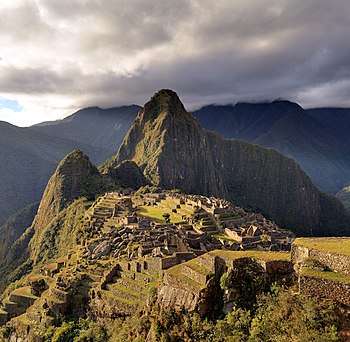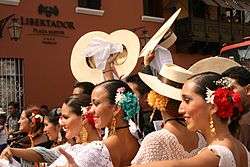Peruvians
 | |
| Total population | |
|---|---|
|
c. 38 million (Peruvian citizenship and ancestry worldwide) | |
| Regions with significant populations | |
|
(Population living in Peru according to the 2017 census) | |
| 626,789[1] | |
| 319,183[2] | |
| 266,244[3] | |
| 120,000[4] | |
| 109,668 | |
| 98,974 | |
| 60,000 | |
| 34,385[5] | |
| 22,002 | |
| 20,000 | |
| 9,000[6] | |
| 7,634[7] | |
| 6,427[8] | |
| 5,886 | |
| 5,000 | |
| 4,042[9] | |
| 1,590[10] | |
| Languages | |
| Languages of Peru, Peruvian Coast Spanish, Quechua | |
| Religion | |
| Christianity (Catholicism, Evangelical),[11] minorities of other religions. | |
Peruvians (Spanish: Peruanos) are the citizens of the Republic of Peru or their descendants abroad. Peru is a multiethnic country formed by the combination of different groups over five centuries, so people in Peru usually treat their nationality as a citizenship rather than an ethnicity. Amerindians inhabited Peruvian territory for several millennia before Spanish Conquest in the 16th century; according to historian David N. Cook their population decreased from an estimated 5–9 million in the 1520s to around 600,000 in 1620 mainly because of infectious diseases.[12] Spaniards and Africans arrived in large numbers under colonial rule, mixing widely with each other and with indigenous peoples. During the Republic, there has been a gradual immigration of European people (specially from Spain and Italy, and in a less extent from France, the Balkans, Portugal, Great Britain and Germany). Japanese and Chinese arrived in large numbers at the end of nineteenth century.
With 31.2 million inhabitants according to the 2017 Census, Peru is the fifth most populous country in South America.[13] Its demographic growth rate declined from 2.6% to 1.6% between 1950 and 2000; population is expected to reach approximately 46 - 51 million in 2050.[14] As of 2017, 79.3% lived in urban areas and 20.7% in rural areas.[15] Major cities include Lima, home to over 9.5 million people, Arequipa, Trujillo, Chiclayo, Piura, Iquitos, Huancayo, Cusco and Pucallpa, all of which reported more than 250,000 inhabitants.[16] The largest expatriate Peruvian communities are in the United States (Peruvian Americans), South America (Argentina, Chile, Venezuela and Brazil), Europe (Spain, Italy, France and the United Kingdom), Japan, Australia and Canada.
Ethnic structure of Peru
In the 2017 Census, 60.2% of Peruvians self-identified as Mestizos, 22.3% as Quechuas, 5.9% as White, 3.6% as Black/Mulatto, 2.4% as Aymaras, 0.3% as Amazonians, 0.1% as Tusán, 0.1% as Nikkei and 1.1% as Others.[17] Amerindians are found in the southern Andes, though a large portion, also to be found in the southern and central coast due to the massive internal labor migration from remote Andean regions to coastal cities, during the past four decades.
Mestizos
Mestizos compose 60.2% of the total population. The term traditionally denotes Amerindian and European ancestry (mostly Spanish ancestry). This term was part of the caste classification used during colonial times, whereby people of exclusive Spanish descent who were born in the colonies were called criollos, people of mixed Amerindian and Spanish descent were called mestizos, those of African and Spanish descent were called mulattos, and those of Amerindian and African descent were called zambos. Most mestizos are urban dwellers and show stronger European inheritance in regions like Lima Region, La Libertad Region, Callao Region, Cajamarca Region, Piura Region, Lambayeque Region, and Arequipa Region.
Amerindians
Amerindians constitute 25.7% of the total population.[17] The two major indigenous or ethnic groups are the Quechuas (belonging to various cultural subgroups), followed by the Aymaras, mostly found in the extreme southern Andes. A large proportion of the indigenous population who live in the Andean highlands still speak Quechua or Aymara, and have vibrant cultural traditions, some of which were part of the Inca Empire.
Dozens of indigenous cultures are also dispersed throughout the country beyond the Andes Mountains in the Amazon basin. This region is rapidly becoming urbanized. Important urban centers include Iquitos, Nauta, Puerto Maldonado, Pucallpa and Yurimaguas. This region is home to numerous indigenous peoples, though they do not constitute a large proportion of the total population. Examples of indigenous peoples residing in eastern Peru include the Shipibo, Urarina,[18] Cocama, and Aguaruna.
European
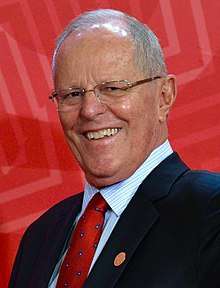
European descendants total 5.9% of the total population. They are mostly descendants of the Spanish colonizers. And other Europeans such as Italians, British, French, Germans, Irish, Dutch, Portuguese, Swiss, Poles and Croatians (see also Croatian Peruvian) who arrived in the 19th and 20th centuries. The majority of them live also in the largest cities, usually in the North and Center cities of Peru: Lima, Trujillo, Chiclayo, and Piura.
The only southern city with a significant white population is Arequipa. Also Oxapampa and Pozuzo in the Pasco Region, and through all Northwest (mainly the highlands of the Coast Regions, Cajamarca Region and part of the San Martin Region), a considerable white population can be found, mostly descendants of Spanish, German, British, French and Italian settlers. Recently, Peru has seen a migration of American retirees and businessmen come to settle in the country, due to lower cost of living and economic booms from the year 2000 to present.
Asian
There is also a large presence of Asian Peruvians, primarily east Asian Chinese and Japanese along with more recently arrived Filipinos[19] and other Asian immigrants, that constitutes 0.2% of the population.
Peru has the second largest population of people of Japanese descent in Latin America after Brazil and the largest population of Chinese descent in Latin America. Historic communities inhabited by people of Chinese descent are found throughout the Peruvian upper Amazon, including cities such as Yurimaguas, Nauta, Iquitos and the north central coast (Lambayeque and Trujillo).
In contrast to the Japanese community in Peru, the Chinese appear to have intermarried much more since they came to work in the rice fields during the Viceroyalty and to replace the African slaves, during the abolition of slavery itself. Despite the presence of Peruvians of Asian heritage being quite recent, in the past decade they have made significant advancements in business and political fields; a past president (Alberto Fujimori), several past cabinet members, and one member of the Peruvian congress are of Japanese or Chinese origin. Large numbers of Arab Peruvians, mostly of Lebanese, Syrian and Iraqis origin and Palestinians also reside, as well a small Jewish, Hindustani and Pakistani communities.
Afro-Peruvian
The remaining is constituted by Afro-Peruvians, which are around 3.6%[20] a legacy of Peru's history as an importer of slaves during the colonial period. Today also mulattos (mixed African and European) and zambos (mixed African and Amerindian) constitute an important part of the population as well, especially in Piura, Tumbes, Lambayeque, Lima and Ica regions. The Afro-Peruvian population is concentrated mostly in coastal cities south of Lima, such as that of those found in the Ica Region, in cities like Cañete, Chincha, Ica, Nazca and Acarí in the border with the Arequipa Region.
Another large but poorly promoted segment of Afro-Peruvian presence is in the Yunga regions (west and just below the Andean chain of northern Peru), (i.e., Piura and Lambayeque), where sugarcane, lemon, and mango production are still of importance. Important communities are found all over the Morropón Province, such as in the city of Chulucanas. One of them is Yapatera, a community in the same city, as well as smaller farming communities like Pabur or La Matanza and even in the mountainous region near Canchaque. Further south, the colonial city of Zaña or farming towns like Capote and Tuman in Lambayeque are also important regions with Afro-Peruvian presence.
Immigration after independence
After independence, there has been a gradual European immigration from England, France, Germany, Italy, Austria, Croatia and Spain.[21]
Polynesians also came to the country lured to work in the Guano islands during the boom years of this commodity around the 1860s. Chinese arrived in the 1850s as a replacement for slave workers in the sugar plantations of the north coast and have since become a major influence in Peruvian society.[22] Other immigrant groups include Arabs, South Asians, Japanese and Americans from the United States.
Languages
Spanish, the first language of 82.6% of Peruvians aged five and older in 2017, is the primary language of the country. It coexists with several indigenous languages, the most common of which is Quechua, spoken by 13.9% of the population. Other native and foreign languages were spoken at that time by 0.8% and 0.2% of Peruvians, respectively.[23] Literacy was estimated at 94.2% in 2017; this rate is lower in rural areas (83%) than in urban areas (96.8%).[24]
Religions
In the 2017 census, 76% of the population over 12 years old described themselves as Catholic, 14.1% as Evangelical, 4.8% as Other, and 5.1% as non-religious.[25] Lord of Miracles is a mural painted by a black slave in the 17th century of Jesus Christ that is venerated in Lima and the main Catholic festivity in Peru and one of the biggest processions around the world.
Every year, in October, hundreds of thousands of faithful from all races and economic backgrounds dresses in purple to celebrate the also known "Black Christ" in a religious procession through the streets of Lima. Without doubt the earthquakes by Lima during the 17th and 18th Centuries, which destroyed most of the city leaving only that mural standing up, contributed to the growth and the solidification of devoted veneration to the mural known as "Christ of Pachacamilla".
Culture

Peruvian culture is primarily rooted in Amerindian and Spanish traditions,[26] though it has also been influenced by various African, Asian, and European ethnic groups. Peruvian artistic traditions date back to the elaborate pottery, textiles, jewelry, and sculpture of Pre-Inca cultures. The Incas maintained these crafts and made architectural achievements including the construction of Machu Picchu. Baroque dominated colonial art, though modified by native traditions.[27] During this period, most art focused on religious subjects; the numerous churches of the era and the paintings of the Cuzco School are representative.[28] Arts stagnated after independence until the emergence of Indigenismo in the early 20th century.[29] Since the 1950s, Peruvian art has been eclectic and shaped by both foreign and local art currents.[30]
Literature
Peruvian literature has its roots in the oral traditions of pre-Columbian civilizations. Spaniards introduced writing in the 16th century; colonial literary expression included chronicles and religious literature. After independence, Costumbrism and Romanticism became the most common literary genres, as exemplified in the works of Ricardo Palma.[31] In the early 20th century, the Indigenismo movement produced such writers as Ciro Alegría,[32] José María Arguedas,[33] and César Vallejo.[34] During the second half of the century, Peruvian literature became more widely known because of authors such as Nobel laureate Mario Vargas Llosa, a leading member of the Latin American Boom.[35] María Jesús Alvarado Rivera was a Peruvian rebel feminist, educator, journalist, writer and social activist who was noted by the National Council of Women of Peru in 1969 as the "first modern champion of women's rights in Peru".[36]
Architecture
Cuisine
Peruvian cuisine is a blend of Amerindian and Spanish food with strong influences from African, Arab, Italian, Chinese, and Japanese cooking.[37] Common dishes include anticuchos, ceviche and pachamanca. Because of the variety of climates within Peru, a wide range of plants and animals are available for cooking.[38] Peruvian cuisine has recently received acclaim due to its diversity of ingredients and techniques.[39]
Music
Peruvian music has Andean, Spanish and African roots.[40] In pre-Hispanic times, musical expressions varied widely from region to region; the quena and the tinya were two common instruments.[41] Spanish conquest brought the introduction of new instruments such as the guitar and the harp, as well as the development of crossbred instruments like the charango.[42] African contributions to Peruvian music include its rhythms and the cajón, a percussion instrument.[43] Peruvian folk dances include marinera, tondero and huayno.[44]
See also
Gallery
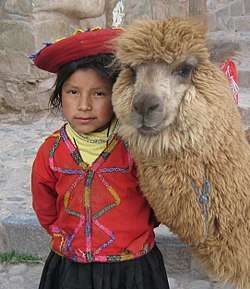 Quechua girl.
Quechua girl.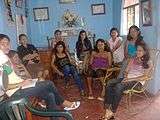 Peruvian women in Iquitos.
Peruvian women in Iquitos.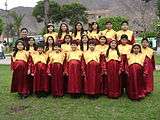 Children choir from El Agustino
Children choir from El Agustino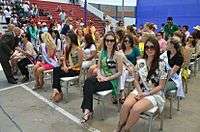 At the Trujillo Spring Festival
At the Trujillo Spring Festival
References
- ↑ "Hispanic or Latino origin by specific origin: 2014 American Community Survey 1-Year Estimates". United States Census Bureau. 2014. Retrieved 25 July 2016.
- ↑ "SÍNTESIS ESTADÍSTICA DE RADICACIONES" (PDF). 2014. Retrieved 5 December 2016.
- ↑ "Extranjeros en Chile superan el millón 110 mil y el 72% se concentra en dos regiones: Antofagasta y Metropolitana" (in Spanish). El Mercurio. 2018-04-09.
- ↑ "La colonia peruana en España se redujo 15% en 6 meses" [Peruvian colony in Spain fell 15% in 6 months] (in Spanish). Elcomercio.pe. 11 December 2014. Retrieved 24 July 2016.
- ↑ "Elecciones Perú 2016: más de 13.000 ciudadanos podrán votar en Quebec y Ontario" [Peru Elections 2016: more than 13,000 citizens may vote in Quebec and Ontario] (in Spanish). Nmnoticias.ca. 8 April 2016. Retrieved 24 July 2016.
- ↑ "Anzahl der Ausländer in Deutschland nach Herkunftsland (Stand: 31. Dezember 2014)".
- ↑ "Utrikes födda efter födelseland, kön och år". www.scb.se. Statistiska Centralbyrån. Retrieved 25 May 2017.
- ↑ "20680-Ancestry (full classification list) by Sex - Australia". Australian Bureau of Statistics. 2006. Archived from the original on 10 March 2008.
- ↑ Fuente — Sección de Estadística. DANE 2005."?". Retrieved 23 May 2013.
- ↑ "Bevölkerung nach Staatsangehörigkeit und Geburtsland" [Population by citizenship and country of birth] (in German). Statistics Austria. 22 June 2016. Retrieved 24 July 2016.
- ↑ The Latin American Socio-Religious Studies Program / Programa Latinoamericano de Estudios Sociorreligiosos (PROLADES) PROLADES Religion in America by country
- ↑ Noble David Cook, Demographic collapse: Indian Peru, 1520–1620, p. 114.
- ↑ "Perú: Perfil Sociodemográfico" (PDF). Instituto Nacional de Estadística e Informática. p. 13.
- ↑ Instituto Nacional de Estadística e Informática, Perú: Estimaciones y Proyecciones de Población, 1950–2050, pp. 37–38, 40.
- ↑ "Perú: Perfil Sociodemográfico" (PDF). Instituto Nacional de Estadística e Informática. p. 15.
- ↑ "Perú: Perfil Sociodemográfico" (PDF). Instituto Nacional de Estadística e Informática. p. 27.
- 1 2 3 "Perú: Perfil Sociodemográfico" (PDF). Instituto Nacional de Estadística e Informática. p. 214.
- ↑ Dean, Bartholomew 2009 Urarina Society, Cosmology, and History in Peruvian Amazonia, Gainesville: University Press of Florida ISBN 978-0-8130-3378-5
- ↑ "Filipino American History". Northern California Pilipino American Student Organization. California State University, Chico. 1999. Archived from the original on 12 October 1999. Retrieved 11 January 2017.
- ↑ "Perú: Perfil Sociodemográfico" (PDF). Instituto Nacional de Estadística e Informática. p. 15.
- ↑ Mario Vázquez, "Immigration and mestizaje in nineteenth-century Peru", pp. 79–81.
- ↑ Magnus Mörner, Race mixture in the history of Latin America, p. 131.
- ↑ "Perú: Perfil Sociodemográfico" (PDF). Instituto Nacional de Estadística e Informática. p. 197.
- ↑ "Perú: Perfil Sociodemográfico" (PDF). Instituto Nacional de Estadística e Informática. p. 137.
- ↑ "Perú: Perfil Sociodemográfico" (PDF). Instituto Nacional de Estadística e Informática. p. 231.
- ↑ Víctor Andrés Belaunde, Peruanidad, p. 472.
- ↑ Bailey 2005, pp. 72–74.
- ↑ Bailey 2005, p. 263.
- ↑ Edward Lucie-Smith, Latin American art of the 20th century, pp. 76–77, 145–146.
- ↑ Bayón, Concha & Martin 1998, pp. 425–428: In Bayón "Art, 1920–c.1980"
- ↑ Bayón, Concha & Martin 1998, pp. 37–39: In Martin "Literature, music and the visual arts, c. 1820–1870"
- ↑ Bayón, Concha & Martin 1998, pp. 151–152: In Martin "Narrative since 1920"
- ↑ Bayón, Concha & Martin 1998, pp. 178–179: In Martin "Narrative since 1920"
- ↑ Bayón, Concha & Martin 1998, pp. 250–253: In Concha "Poetry 1920–1950"
- ↑ Bayón, Concha & Martin 1998, pp. 186–188: In Martin "Narrative since 1920"
- ↑ Encyclopedia of Women Social Reformers: A-L-v. 2. M-Z. ABC-CLIO. 2001. p. 10. ISBN 978-1-57607-101-4. Retrieved 12 May 2013.
- ↑ Tony Custer, The Art of Peruvian Cuisine, pp. 17–22.
- ↑ Tony Custer, The Art of Peruvian Cuisine, pp. 25–38.
- ↑ Embassy of Peru in the United States, The Peruvian Gastronomy. Retrieved 27 December 2010.
- ↑ Raúl Romero, "Andean Peru", p. 385–386.
- ↑ Dale Olsen, Music of El Dorado, pp. 17–22.
- ↑ Thomas Turino, "Charango", p. 340.
- ↑ Raúl Romero, "La música tradicional y popular", pp. 263–265.
- ↑ Raúl Romero, "La música tradicional y popular", pp. 243–245, 261–263.
Bibliography
- Bailey, Gauvin A. (2005), Art of colonial Latin America, Phaidon, ISBN 978-0-7148-4157-1
- Bayón, Damián; Concha, Jaime; Martin, Gerald (1998), Leslie Bethell, ed., A Cultural History of Latin America: Literature, Music and the Visual Arts in the 19th and 20th Centuries, Cambridge University Press, ISBN 978-1-316-58389-0, retrieved 25 July 2016
.jpg)
.jpg)

